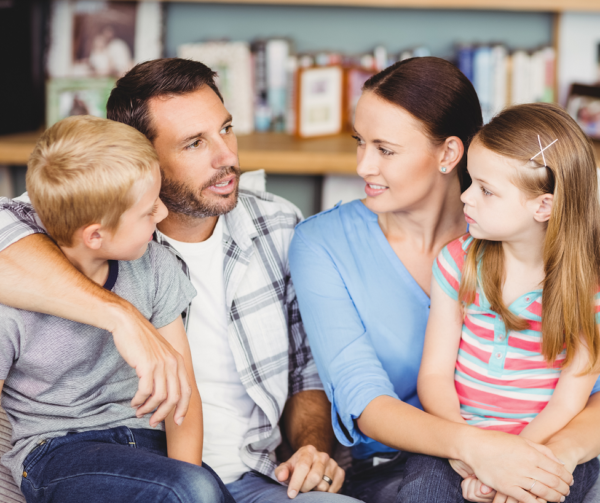
Here’s how you can help
When a child or teenager experiences the challenges of anxiety, it impacts the whole family. Children and teens will usually lean on one parent more than the other for support, comfort and reassurance, and the avoidance that usually accompanies anxiety can be time consuming to manage. Brothers and sisters begin to notice that when anxiety shows up for their sibling it can pull mum or dad away from them, and that brothers or sisters who struggle with anxiety can, at times, be parented quite differently.
These are just some of the ways anxiety impacts family life. It can leave us, as parents, feeling pulled in different directions trying to meet the needs of all of our children, our partner, and our own. Parenting an anxious child or teen can also be really upsetting and tough at times. It can be hard to know where to start to move things in a more positive, helpful direction. I’ve written five suggestions below to get you started.
- Learn as much as you can about anxiety
Understanding that anxiety is the brain and body’s response in anticipation of a threat is an excellent place to start. When a child or teen is feeling anxious, their brain has detected a threat somewhere. It doesn’t matter if the threat is real, imagined or perceived, the brain and body will respond in exactly the same way. The anxiety response triggers a host of physical changes, such as increased heart rate, increased breathing rate, perspiration and shunting of blood from the stomach (to name a few), that will make an anxious person feel awful. Learning about these physical changes and why they’re happening help an anxious child or teen to understand why they feel the way they feel. They’re also more able to recognise their own anxiety when it shows up and draw on their anxiety management skills.
- Teach anxiety management skills
The changes in the body are a key to how we can teach anxious kids and teens to begin settling their anxiety response. Slowing down the rate of breathing begins to show the brain that there’s no threat, that they’re safe. Encouraging longer, deeper, slower inhalation and exhalation helps to dial the anxiety response down and balance the levels of oxygen and carbon dioxide in the brain. Movement is another important strategy to implement. Encouraging anxious kids and teens to move helps bring the anxiety response to a natural end.
- Respond to anxiety with empathy
When your child or teen is anxious the very best and most helpful response you can give them is one filled with compassion, empathy and validation. Hearing ‘I can see this is really hard for you right now’, or ‘anxiety feels plain awful doesn’t it?’, or ‘I’m sorry you’re feeling like this’ all show your anxious child that you see them, you understand what they’re going through and that you’re there for them in that moment.
- Take note of the patterns evolving when anxiety shows up
We all know how awful anxiety feels. Whether you’ve had experience with the normal kind of anxiety that settles after a stressful situation has passed, or you have ongoing anxiety challenges, it’s not much fun. Because it feels pretty awful, and often goes hand-in-hand with lots of painful and distressing thoughts, the obvious and natural response for anyone with anxiety is to avoid whatever it is that’s making them anxious. Wherever possible. This is a pattern most families observe in their homes. Social anxiety can see anxious kids and teens baulking at going to parties, separation anxiety gets in the way of sleepovers and school camps, generalised anxiety disorder can cause kids and teens to stop doing the things that provoke a lot of worrying, and kids with phobias want to make darn sure they’re nowhere in the vicinity of what it is that causes them distress and panic. It makes perfect sense, except sadly, avoidance only serves to dial anxiety up, not down. The alternative is inching anxious kids and teens closer to their challenges over time, and with lots of empathy and compassion. This is called step laddering or Exposure Response Prevention (ERP). A psychologist can support you and your family to develop a step-by-step plan.
- Know when to get help
When anxiety is getting in the way of day-to-day functioning it’s a sure sign that extra help is needed. Although, I always like to tell parents, if you have any questions or concerns at all about your child’s mental health, any, the very best thing to do is to make an appointment with your family doctor for a discussion. Normal anxiety comes and goes with stressful situations. When you observe that your child or teen experiences frequent anxiety, anxiety that’s not clearly related to a known challenge, anxiety that stops them from doing what’s important or is getting in the way of day-to-day life, please seek the help of a professional. Your GP will be able to make an initial assessment and will reassure you that there’s no need for additional help, or that extra help is recommended and who to turn to next. Anxiety is treatable, the sooner the better.
Dr Jodi Richardson is an anxiety specialist available for parent presentations and staff professional development. Contact hello@drjodirichardson.com.au for more information.

share the love
[Sassy_Social_Share]

about
Jodi is on a mission to elevate mental health and wellbeing in families, classrooms and workplaces.


free 5-day
Calm your anxious brain
mini course

Recent Posts

free 5-day
Calm your anxious brain
mini course
Sign up for my free 5-day ‘Calm Your Anxious Brain’ email mini-course. Put the strategies into place for yourself, light the way for your kids, or do both.






